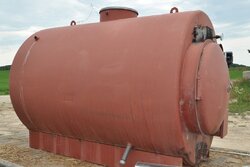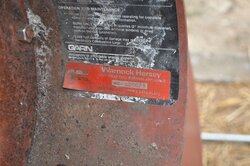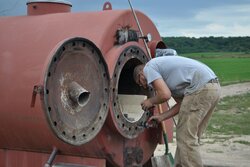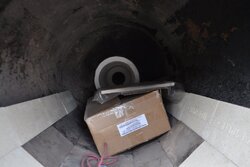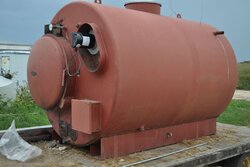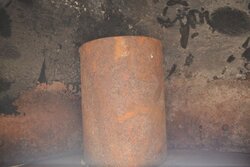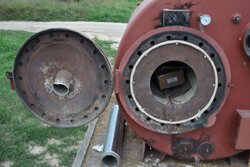We just got done with a complete refurb and overhaul of a very old Garn. Serial number WHI-000029 to be exact. The current owner discovered two of them in an abandoned greenhouse (courtesy of Craigs List) and neither one was in operating condition. Both units sat in the greenhouse for several years according to local people that were familiar with the situation and they had water in them for at least a couple years before developing leaks. Obviously, they both froze solid over the winter at least once.
Number 29 had just a few pinholes in the bottom and the new owner elected to have a "patch plate" welded in place over top the existing metal. (Wouldn't be my first choice but he's payin the bill so......)
Along with a new bottom, we had Dectra/Garn custom make a new blower mounting plate because the old one was designed for a cradle mount motor rather than the C-face style found on new Garns. We put a new blower wheel, mounting plate and motor on it. The blower wheel appeared to be the same as the old one which had obviously come undone during operation. It was twisted and disintegrated beyond recognition. When this happens in a Garn it's usually because there was no water in it when was fired and flue temps went over 900-1000* melting the wheel. It's designed that way.
Along with those parts we got him a new control and lid which accepts the low water level safety. The old lid design does not accept the LWCO stem and it's flat instead of convex like the new lids are. New gaskets were installed everywhere they were needed. And that's about it. There really is not much more to a Garn than that.
Number 29 is going on another farmstead just down the road from the main farm where we installed a WHS-2000 over this past winter. It runs all the heat on the farm for space and hot water (tons) needs. I'll try to put up pictures of that on a different thread.
Number 29 had just a few pinholes in the bottom and the new owner elected to have a "patch plate" welded in place over top the existing metal. (Wouldn't be my first choice but he's payin the bill so......)
Along with a new bottom, we had Dectra/Garn custom make a new blower mounting plate because the old one was designed for a cradle mount motor rather than the C-face style found on new Garns. We put a new blower wheel, mounting plate and motor on it. The blower wheel appeared to be the same as the old one which had obviously come undone during operation. It was twisted and disintegrated beyond recognition. When this happens in a Garn it's usually because there was no water in it when was fired and flue temps went over 900-1000* melting the wheel. It's designed that way.
Along with those parts we got him a new control and lid which accepts the low water level safety. The old lid design does not accept the LWCO stem and it's flat instead of convex like the new lids are. New gaskets were installed everywhere they were needed. And that's about it. There really is not much more to a Garn than that.
Number 29 is going on another farmstead just down the road from the main farm where we installed a WHS-2000 over this past winter. It runs all the heat on the farm for space and hot water (tons) needs. I'll try to put up pictures of that on a different thread.


